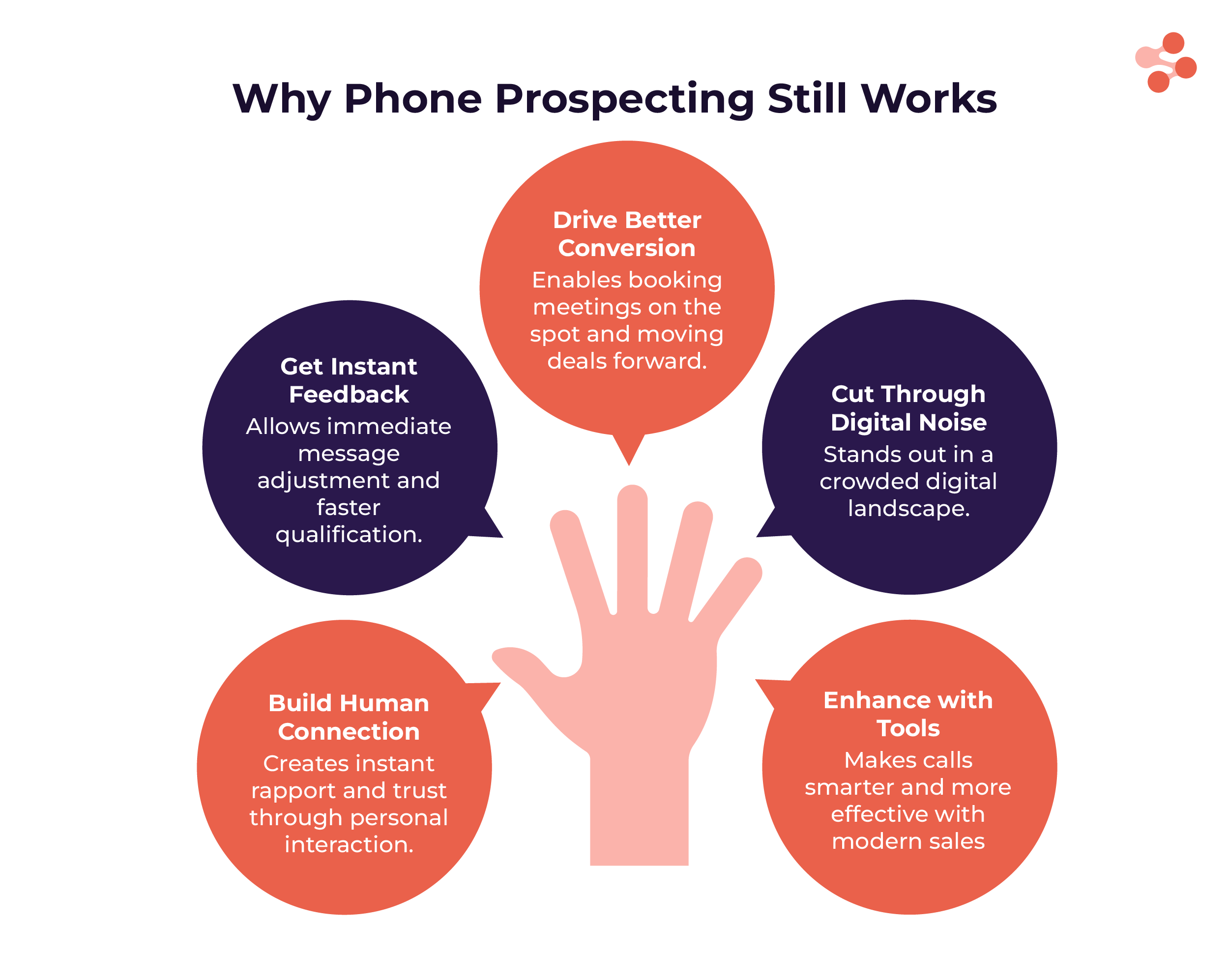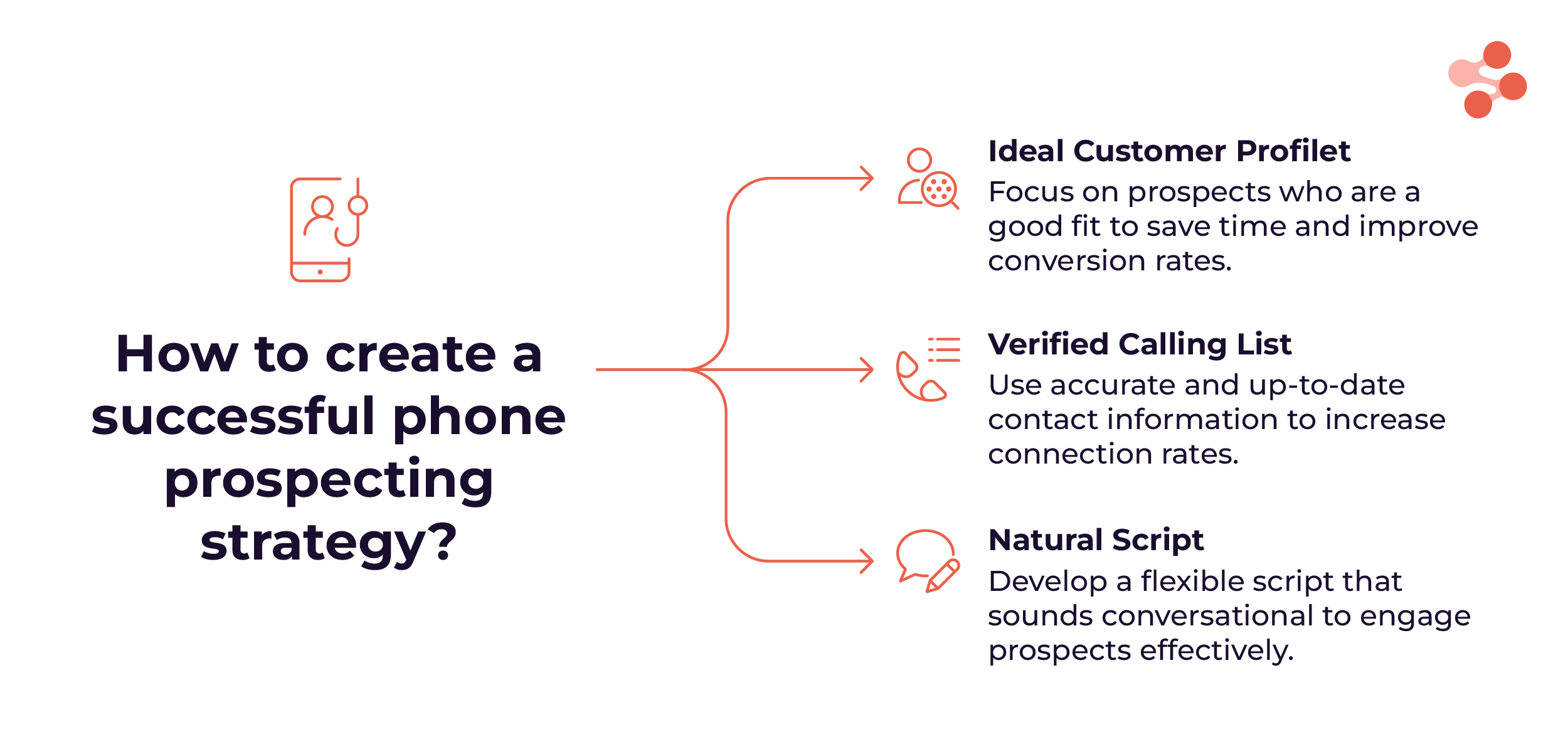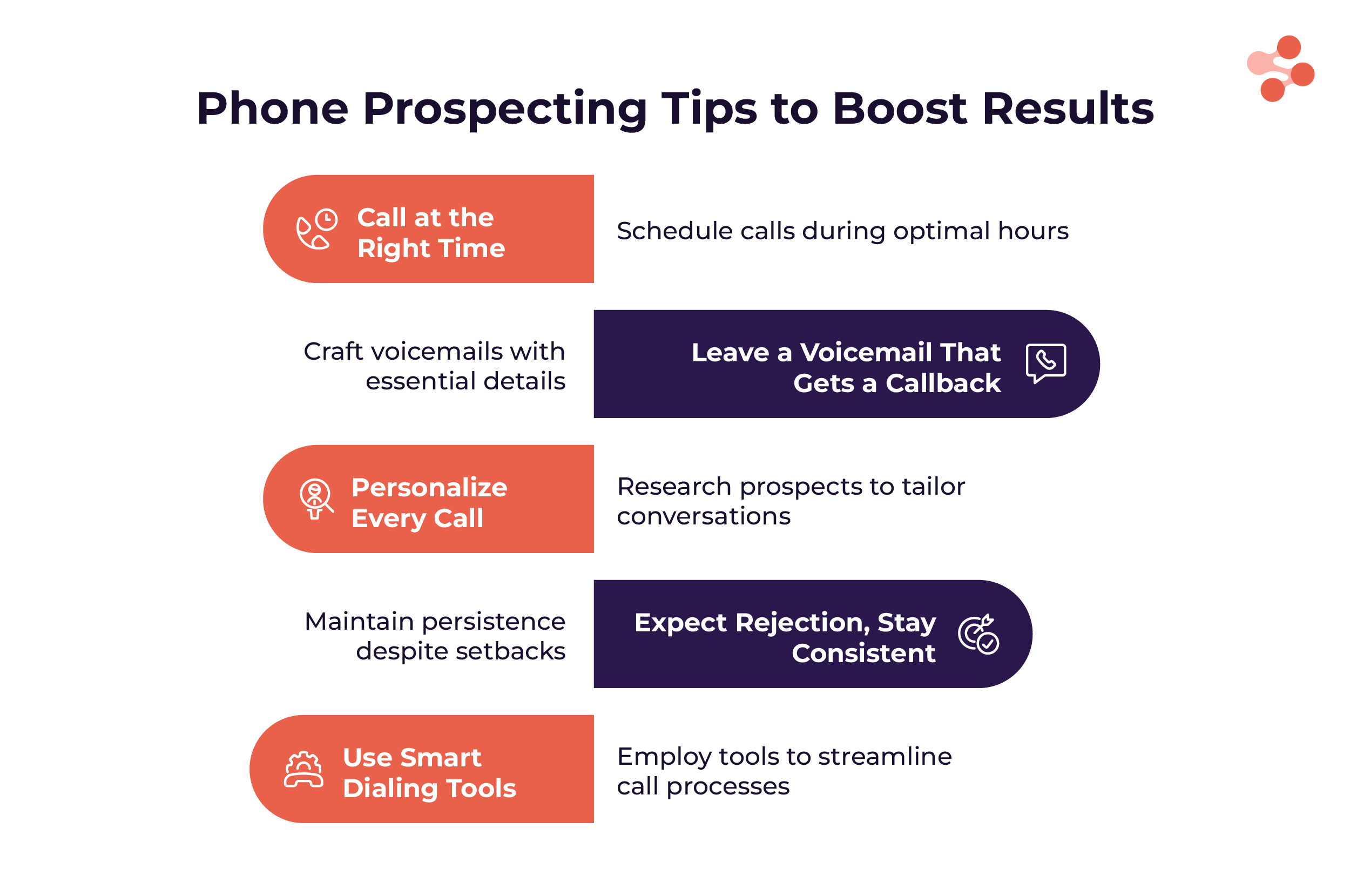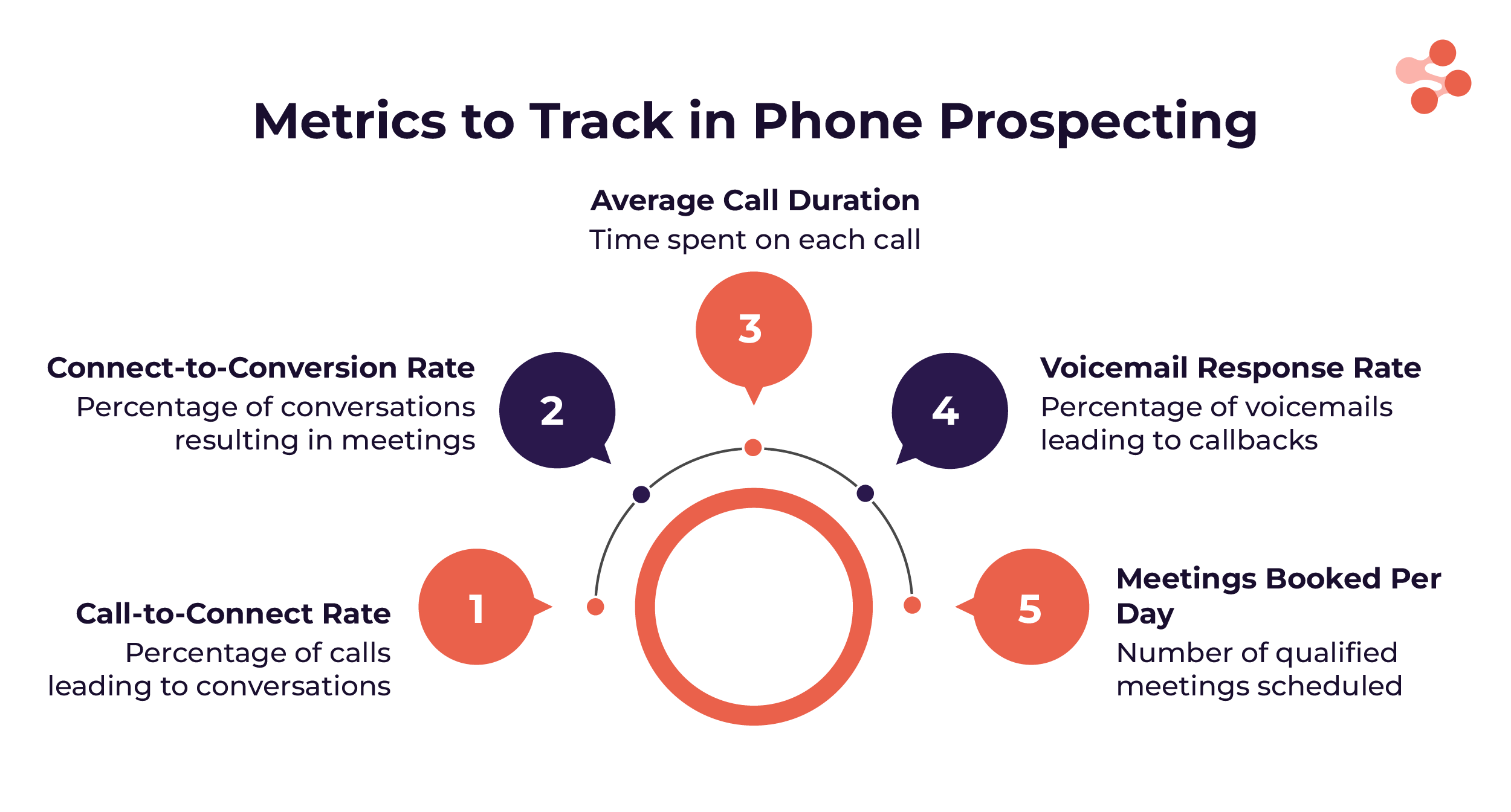Table of Content
Phone prospecting is often overlooked—but it’s still one of the fastest ways to reach your ideal customer. The problem? Most reps either give up too early or sound scripted when they finally get someone on the line.
Without the right approach, calls get ignored, conversations fall flat, and results stay low.
In this guide, we’ll share proven phone prospecting strategies, practical tips, and high-performing scripts built for 2025. Whether you're booking meetings or qualifying leads, these insights will help you connect faster and close stronger—one call at a time.
What Is Telephone Prospecting?
Telephone prospecting is the process of calling potential buyers to spark interest, start conversations, and qualify leads. It’s a key part of outbound sales. Sales Development Reps (SDRs), Business Development Reps (BDRs), and Account Executives (AEs) use it to reach decision-makers fast.
Unlike emails or LinkedIn messages, a phone call demands attention. You get instant feedback. You hear tone, objections, and intent in real time. That’s gold for any seller.
Many believe cold calling is outdated. In truth, it still works—if you know how to do it right. The best reps don’t just dial. They research the prospect, personalize the pitch, and time their calls well. This turns a cold call into a warm conversation.
Done with skill, phone prospecting cuts through digital noise and builds human connection. It helps reps qualify faster, handle objections live, and move deals forward quicker.
Why Telephone Prospecting Still Works
Some say cold calling is dead. But that’s not true. Phone prospecting has evolved. With better tools, data, and targeting, it still plays a key role in outbound sales.

1. Builds Real Human Connection
A live phone call creates instant rapport. You can hear tone and emotion. This helps build trust faster than emails or messages. It feels personal and real.
2. Gives Instant Feedback
You get a response right away. If the prospect is interested, you know it. If not, you can adjust your message or ask the right questions. This saves time and helps you qualify faster.
3. Drives Better Conversion
When you reach the right person, you can often book a meeting on the spot. You skip the back-and-forth of email threads. A single call can move the deal forward.
4. Cuts Through Digital Noise
Email inboxes are full. Social media is crowded. But fewer people make calls today. That means a good phone call stands out. It breaks through the noise and gets attention.
5. Works Even Better with the Right Tools
Modern sales tools make calling smarter. You can use intent data, direct dials, and real-time insights to reach the right person at the right time. This makes each call more effective and less random.
Key Components of a Successful Phone Prospecting Strategy
Phone prospecting works best when it’s built on a clear plan, strong data, and smart targeting. Random dialing doesn’t get results anymore. To succeed, you need to call the right people, at the right time, with the right message.
Here are the core parts of a winning phone prospecting strategy.

1. Know Your Ideal Customer Profile (ICP)
Before making any call, you need to know who you’re calling—and why. Your Ideal Customer Profile (ICP) helps you focus only on prospects who are a good fit. This saves time and improves your conversion rate.
Build your ICP using firmographic and technographic filters like:
- Industry (for example, SaaS, healthcare, manufacturing)
- Company size (employee count or revenue)
- Job title or seniority (decision-makers like Head of Sales or IT Director)
- Tech stack (what tools or platforms they already use)
- Buying signals (hiring activity, funding rounds, or recent product launches)
A clear ICP helps sales reps avoid low-value leads and connect with high-potential buyers. B2B data providers and sales intelligence tools like SMARTe can help you filter and build lists that match your ICP.
2. Use a Verified Calling List
The quality of your lead list matters more than the quantity. Calling outdated or incorrect numbers leads to low connection rates and wasted time. That’s why you need a verified phone number list built for outbound sales.
Look for these must-have elements in your calling list:
- Direct dials: Reach your prospect without going through a company gatekeeper.
- Mobile numbers: Higher chances of connection, especially with remote or hybrid workers.
- Role-based contacts: Call people with buying power or influence, not just random employees.
- Fresh data: Use recently verified contact information to avoid bouncebacks and wrong numbers.
- Phone number lookup tools: Use them to quickly verify or find missing numbers, ensuring your list is complete and accurate.
Phone prospecting is most effective when it’s part of a focused sales prospecting strategy. Random dialing no longer works. To get real results, you need a clear plan, accurate data, and precise targeting. It’s about reaching the right people, at the right time, with the right message.
3. Write a Phone Prospecting Script That Sounds Natural
A good sales call doesn’t feel scripted—it feels like a real conversation. Instead of reading word-for-word, use a simple, flexible framework that you can adapt on the fly.
- Opener: “Hi [Name], this is [Your Name] from [Company]. Did I catch you at a bad time?”
- Value Statement: “I work with [similar companies] to help with [specific problem or goal].”
- Qualifying Question: “How are you currently handling [pain point]?”
- Call-to-Action: “Would it make sense to set up a quick 15-minute call to explore this?”
Practice your script until it sounds natural, clear, and confident. The goal is to start a conversation—not deliver a pitch.
Phone Prospecting Tips to Boost Results
Cold calling works best when done with purpose, not pressure. To get better results, reps need the right habits, tools, and timing. Here are five phone prospecting tips that actually help you connect and convert.

1. Call at the Right Time
Your timing can make or break the call. Early mornings and late afternoons tend to work best.
- Try calling between 8–10 AM or 4–6 PM
- Avoid Monday mornings and Friday afternoons
- Always adjust to the prospect’s time zone
These windows catch people when they’re more open to quick conversations. Smart timing leads to more pickups and better first impressions.
2. Leave a Voicemail That Gets a Callback
Not every call will be answered. But a good voicemail can still create interest. Keep it short and useful.
Include these four parts:
- Your name and company
- A quick value point that matters to them
- Your phone number, clearly and twice
- A clear ask, like a callback
Example:
“Hi [Name], this is Jenna from AlphaTech. We help growing teams cut churn using real-time insights. I’d love to share more. Call me at 555-123-4567. Again, 555-123-4567.”
A voicemail like this shows value and makes it easy to respond.
3. Personalize Every Call
Prospects can tell when you didn’t prepare. A little research goes a long way.
Before calling, check:
- Their job title and role
- Any recent company news
- What tools or platforms they use
- Possible challenges they might face
Bringing up relevant points shows respect for their time. It also helps start real conversations—not just another sales pitch.
4. Expect Rejection, Stay Consistent
Most calls won’t lead to a win right away. That’s normal. What matters is sticking with it.
Here’s what top reps aim for:
- 60 to 100 dials a day
- 6 to 8 follow-ups per prospect
- Mix of calls, voicemails, emails, and LinkedIn touches
Phone prospecting is a long game. Each “no” brings you closer to a “yes.”
5. Use Smart Dialing Tools
Manual dialing slows you down. Tools like power dialers help speed things up and reduce wasted time.
With a power dialer, you can:
- Auto-call leads from your list
- Cut the time between calls
- Focus more on talking, less on clicking
The more calls you make, the better your chances—especially when each one is well-prepared.
Metrics to Track in Phone Prospecting
If you want to improve your phone prospecting, you need to measure it. Tracking the right metrics helps you see what’s working, where to adjust, and how to scale success.
Here are the five most important phone prospecting metrics to track:

1. Call-to-Connect Rate
What it is: The percentage of calls that lead to live conversations.
Why it matters: A low rate means your list may be outdated or you’re calling at the wrong time.
How to calculate:
(Number of connects ÷ Total calls) × 100
This metric helps you test and improve your call timing, list quality, and pickup rates.
2. Connect-to-Conversion Rate
What it is: The percentage of conversations that result in booked meetings.
Why it matters: It shows how well you're qualifying leads and communicating value.
How to calculate:
(Meetings booked ÷ Number of connects) × 100
A strong conversion rate means your pitch is working and you’re targeting the right people.
3. Average Call Duration
What it is: The average time spent on each live call.
Why it matters: Longer calls can show interest, but short, focused calls often convert faster.
Track this with context. A long call with no follow-up may not be worth more than a short one that books a meeting.
4. Voicemail Response Rate
What it is: The percentage of voicemails that lead to callbacks.
Why it matters: This shows how effective your voicemail script is.
How to calculate:
(Callbacks ÷ Voicemails left) × 100
Low response? Try a shorter message, add a clear value point, and repeat your number twice.
5. Meetings Booked Per Day
What it is: The number of qualified meetings you schedule daily.
Why it matters: This is your key output metric. It shows if your efforts are turning into real pipeline.
Track this over time to understand trends, improve consistency, and set clear activity goals.
Final Tip: These metrics work best when tracked together. They help you fine-tune your cold calling strategy, improve your list quality, and increase conversions—call by call.
Top Phone Prospecting Scripts That Work in 2025
A phone script should never feel like a script. In 2025, the most effective sales reps don’t sound rehearsed—they sound real. They use simple words, ask smart questions, and guide the conversation without pressure. Good phone prospecting is about starting honest conversations, not pitching a product in 30 seconds.
Below are call script styles that work today. Each one is built to feel natural, get the prospect talking, and lead to a clear next step.
1. The Simple Value Script
This is great for first-time outreach. It’s short, clear, and shows you’re calling with purpose.
Example:
“Hi [Name], this is [Your Name] from [Company]. We help teams save time on [problem area]. Just wanted to ask—how are you handling that right now?”
If the person shows interest, move forward. If not, thank them and offer to reconnect later.
Why it works: It respects their time and gets to the point. There’s no hard sell—just a clear reason to talk.
2. The Personalized Hook Script
This script works well when you’ve done your homework. Mention something real—like a recent update, job change, or project.
Example:
“Hi [Name], this is [Your Name]. I noticed your team recently rolled out [specific change]. We’ve helped others during that shift by [quick benefit]. Thought it was worth a quick call—does that sound familiar?”
Why it works: It shows you’re not dialing at random. Even a small personal touch goes a long way.
3. The Problem-Focused Script
Use this when you know a common challenge the person might face. Focus on the issue first—then offer a way to help.
Example:
“Hey [Name], this is [Your Name]. A lot of teams we speak with are struggling with [pain point]. We’ve been working on ways to fix that without adding more tools. Is that something you’re dealing with too?”
Why it works: It starts with something they care about. People respond more when they feel understood.
4. The Familiar Style Script
This approach helps your call feel less like a stranger reaching out. You reference people in a similar role or space, without pretending it’s a referral.
Example:
“Hi [Name], this is [Your Name]. I’ve been speaking with others in similar roles lately, and your name came up during my research. We’ve helped teams improve [result]. Curious—how are you tackling that right now?”
Why it works: It sounds familiar and lowers resistance. The tone feels conversational, not scripted.
5. The Follow-Up Script
This one’s useful after a voicemail, email, or LinkedIn message. Keep it light, and remind them why you’re calling.
Example:
“Hi [Name], [Your Name] here again. I sent you a quick note earlier this week about [specific value]. Just wanted to follow up and see if now’s a better time to chat.”
Why it works: It’s casual and consistent. You stay on their radar without being pushy.
How to Make These Scripts Work for You
- Don’t memorize—practice. Know the flow, not the lines.
- Always sound like yourself. If it doesn’t feel natural, change it.
- Keep the tone friendly and clear. Be confident but never pushy.
- Adjust based on what the person says. A good call is a two-way street.
- Be ready to follow up. One call isn’t always enough to get a yes.
The best phone scripts in 2025 are the ones that feel like real conversations. They help you connect, build trust, and find out if there's a fit. Whether you're reaching out cold or following up, use these styles to guide the call—not control it. Keep it human. Keep it honest. That’s what makes people listen.
How SMARTe Helps You Win at Phone Prospecting
Phone prospecting works best when you call the right person using the right number. SMARTe helps you do exactly that.
It’s a sales prospecting tool built to make calling faster, easier, and more effective. With SMARTe, you spend less time chasing dead numbers and more time having real conversations.
Reach More Prospects, Skip the Voicemail
SMARTe gives you access to verified mobile numbers. With this, you can find someone's phone number easily. It covers 70% of contacts in North America and 50% across EMEA, APAC, and LATAM. This helps you get past gatekeepers and talk directly to decision-makers.
No more endless voicemail loops. No more wasted dials.
Build Smarter Call Lists
Stop guessing who to call next. Use filters like industry, company size, job title, and tech stack to target the right people.
Whether you need decision-makers in tech companies or buyers in manufacturing, SMARTe helps you build a precise cold call list in minutes.
Prospect Without Leaving Your Browser
While prospecting on LinkedIn or viewing a company website, SMARTe’s browser extension shows contact details instantly. You can view direct phone numbers, save the information, or push it to your CRM with one click. This helps you move from research to calling without losing momentum.
Make Every Call Count
SMARTe helps you avoid bad data and connect with real people. That means fewer wasted dials and more qualified conversations.
It gives your sales team the speed, accuracy, and confidence to win on the phone.
Book a demo today and see how SMARTe makes phone prospecting simple, fast, and effective.










